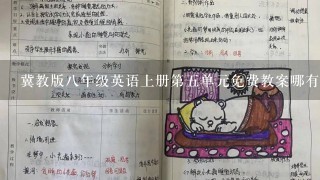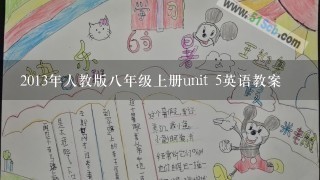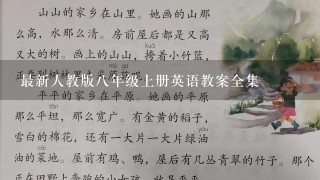新目标八年级英语上册unit8课件免费下载网址,冀教版八年级英语上册第五单元免费教案哪有?急用!

1、新目标八年级英语上册unit8课件免费下载网址
www.***.com. 那里有一大堆。

2、冀教版八年级英语上册第五单元免费教案哪有?急用!
冀教版英语八年级下册第五单元教案 Lesson 33: How Can You Go? Teaching Content: Mastery words and expressions: anywhere, type, ship, rapid, on foot, of course Oral words and expressions: transportation Teaching Aims:
1、 Learn the information about the transportation.
2、 Know the transportation history and what the future transportation will be like. Teaching Important Points:
1、 How many types of transportation are there in the world?
2、 Talk about all kinds of transportation. Teaching Difficult Points: Discuss the advantages and the disadvantages of all kinds of transportation. Teaching Preparation: pictures Teaching Aids: audiotape, flashcards, pictures Type of lesson: new lesson Teaching Procedure: Step
1、 Lead in the class. Let the students discuss the following questions: How do you come to school every day? Why? S1: I come to school on foot because my home is near the school. S2: I come to school by bike because I ride my bike well. S3: I come to school by bus because my home is far away from school. Step
2、 Let the students ask questions about the transportation. Such as: what do you take if you go on a trip to Beijing? Why? Can you describe your favourite trip to the class? Step
3、 Listen to the tape and do with Exercise 2 in the activity book with the books closed. Step
4、 Read the text and check the answers. Then read the text again and repeat after it. After a while, ask some students to read the text loudly in roles. Step
5、 Make sentences with the phrases: what about, on foot, take a car, would like, more rapid Step
6、 Practice Discuss the following question: What is the advantages and disadvantages of the transportations? Such as: cars, trains, and buses. If you go on a trip, where would you like to go? How will you go there? Let the students work in groups of three of four. After a while, present their answers to the class. Step
7、 Come to “ LET’S DO IT.” Ask the students to talk in the class. Then they can give their presentation in dialogues or in composition. Encourage them to report one by one. Step
8、 Homework
1、 Finish off the activity book.
2、 Go on the next reading in the student book. Summary: When the students make their presentation to the class. Remember to remind them to speak in turn. We should let all the students have the chances to speak. If someone can’t go on, the others may help him. Lesson 34: Trains Go on Rails! Teaching Content: Mastery words and expressions: invent, wheel, engineer, railway, passenger, speed, even, get on/off Oral words and expressions: rail, invention, steam, engine, locomotive, explode, distance, iron, per, magnetic, jet, jet engine, get on/off, (at) a top speed of Teaching Aims:
1、 Know about the train history.
2、 What will the future train be like? Teaching Important Points: The invention of the steam engine, the first steam locomotive, railways and the first passenger. Teaching Difficult Points: Who invented the inventions and when did they invent them. Teaching Preparation: pictures Teaching Aids: audiotape, flashcards, pictures Type of lesson: new lesson Teaching Procedure: Step
1、 Come to “THINK ABOUT IT.” Let the students talk in groups about the question: How do you usually travel to some other places? After discussing for a while, the students make a report to the class. Step
2、 Let the students read the text then answer how is the text arranged. Step
3、 Listen to the tape. After repeating the text for several times, ask them to retell the story in their own words. Step
4、Let the students talk more about the trains. They may talk about their experience on trains. They also may talk about the structure of the trains, the use of the trains and the future of them. Step
5、 Make a table. Make a survey about the advantages and the disadvantages of the trains, the cars, the bus, the bicycles and the planes. transporation advantage disadvantages train car bus bicycle plane Step
6、 Come to “LET’S DO IT”. Step
7、 Homework
1、 Finish off the activity book.
2、 Go on the next reading in the student book. Summary: The students know little about the train history. The teacher should arrange much information about it. Show them more pictures and let them know more. Encourage them to imagine the future transportation. Stimulate them to work hard and make their mind to make contribution to the world Lesson 35: Future Transportation Teaching Content: Mastery words and expressions: certainly, invention, present, round, wing, dangerous, factory, humorous, as long as Oral words and expressions: presentation, Henry, Ford, North America, Teaching Aims:
1、 Learn the history of the cars.
2、 Describe one type of transportation in the future. Teaching Important Points:
1、 Learn about the Danny wheels.
2、 Imagine what types of transportation will be like from one hundred years now. Teaching Difficult Points: Let the students think and be creative. Teaching preparation: pictures Teaching Aids: audiotape, flashcards, pictures Type of lesson: new lesson Teaching Procedure: Step
1、 Let the students talk about something about the planes and the cars. What do they know about the planes and the cars? If they know, let them say their details. Step
2、 Ask the students to talk about the picture in the text. What do they think about this? Step
3、 Let’s listen to the tape and answer the following questions:
1、 How did people get to another city before people invented plane?
2、 When did Henry Ford open a car factory?
3、 What’s Danny’s invention?
4、 Would someone like to ride in the Danny’s wheel? Why? Step
4、 Read the text and check the answers. Then let the students read it loudly in class. After a while, ask the students read the text in roles. Step
5、 Let the students act he dialogue out. They can take a circle for Danny’s wheel. Step
6、 Ask some students to make sentences with the following phrases: At that time, need to, present, you’d better not. At that time, I was a little girl. You need to wear warm clothes in cold winter. Present your invention to the class. You’d better say it again. Step
7、 Come to “PROJECT”.
1、 Ask the students to make a survey: ask your grandparents about the old transportation. When they are in a hurry, what did they do? Did they think of the modern transportation today? What do they think of the life today? Remember to make a report to the class.
2、 Talk in groups of three or four. What do you hope the future transportation will be like? Can you invent some useful invention? Report to the class.
3、 Make a detail about your future transporation. Step
8、 Homework
1、 Finish off the activity book.
2、 Go on the next reading in the student book. Summary: Encourage students to make a survey about the old transportation. How did our grandparents go to a big city in the old days? How long did it take? While, we think hard to invent new transportation. What’s its advantages and disadvantages? We can make a detail about it. Lesson 36: Let’s Take a Drive Teaching Content: Mastery words and expressions: drive, countryside, ride Oral words and expressions: drove, driven, highway, rode, ridden, park, afar Teaching Aims:
1、 Feel the charming of the music.
2、 Know what the people in the foreign countries do in their spare time. Teaching Important Points:
1、 Sing the foreign songs together.
2、 Use the modal verbs. Teaching Difficult Points: Grasp some words and patterns: be late for, get out of, you’d better not Teaching Preparation: pictures Teaching Aids: audiotape, flashcards, pictures Type of lesson: new lesson Teaching Procedure: Step
1、 Listen to the tape first. Feel the charming of the music. Step
2、 Ask the students to read the lyric line by line. Divide them into several groups to practice the song. Step
3、 Explain the Chinese meaning of the song. Your translation must be like poem in order to take them to a beautiful situation. Step
4、 Listen to the tape for several times and repeat with it. Step
5、 Work in groups. Talk about the questions:
1、 What do you usually do in your spare time? How do you usually go there? Why?
2、 Talk about your recent journey to the class. What gave your most expression? Step
6、 Practice
1、 the use of modal verb “can”. Can you drive me to school today? Can he go to my home?
2、 the use of modal verb “may”. May I speak in Chinese? May I leave school now?
3、 You’d better not. --May we eat take a photo here? –You’d better not. Look at “NO PHOTOS” sign. --May I smoke? –You’d better not. Look at “NO SMOKING” sign. Step
7、 Homework
1、 Finish off the activity book.
2、 Go on the next reading in the student book. Summary: Today we learn a song. After a piece of music, we feel a mother’s love. Mrs. Dinosaur’s voice is very interesting, which becomes the modal of some students. We deal with the two modal verbs “can and may” again. Now we know it’s used to ask for permission. Lesson 37: Flying Donuts Teaching Content: Oral words and expressions: fuel, imagination Teaching Aims:
1、 Stimulate students’ learning interests.
2、 Cultivate students’ listening by catching the useful information in the listening process. Teaching Important Points:
1、 Encourage students’ to increase creative ability.
2、 Why is the invention called “flying donuts”. Teaching Difficult Points: What’s the theory of an invention? Teaching Preparation: pictures Teaching Aids: audiotape, flashcards, pictures Type of lesson: new lesson Teaching Procedure: Step
1、 Play a Game Let some students explain it in English, while the others guess what it is. You must say the transportation. For example, A transporter is very long. It can hold many people in it. It can also take goods. What is it? Step
2、 Listen to the tape and answer the following questions:
1、 What is Danny’s invention made of?
2、 Why is it called “Flying Donuts”?
3、 Will Danny’s invention really work? Step
3、 Read the text and check the answers. Then listen to the tape again and read after it for several times. Step
4、 Ask the students to read the text in roles. Then act the dialogue in front of the class. Step
5、 Make sentences with the following language points: on the way to school, turn on, at the front of Step
6、 Let’s come to “PROJECT”. Divide the class into small groups of three of four students. Each group chooses a type of transportation for the students. Instruct students to begin collecting information about that type of transportation. They will prepare a comic strip or timetable of important dates in its development. Groups present their work to the class. Depending on class size and the length of presentations, you may wish to divide up the class. Groups would then present their projects to one portion of the class. If the project cannot be finished in one class, it can be continued in the next lesson. Step
7、Homework
1、 Finish off the activity book.
2、 Go on the next reading in the student book. Summary: Let the students create more useful inventions. When one group thinks of a good idea, the others can add their useful information to it. Instruct them to speak in timeline. Lesson 38: Let’s Invent Hoverboard! Teaching Content: Mastery words and expressions: smooth, second, space, sound Oral words and expressions: Sam, hoverboard, skateboard, float, transportation, show, spaceship, all the time, go through Teaching Aims:
1、 Review words and phrases for transportation that the students learned before.
2、 Encourage the students to find and restate information in personal and imaginative ways. Teaching Important Points:
1、 How do you demonstrate your invention?
2、 Learn about the use of Modal Verbs. Teaching Difficult Points: the use of Modal Verbs Teaching Preparation: pictures Teaching Aids: audiotape, flashcards, pictures Type of lesson: new lesson Teaching Procedure: Step
1、 Come to “THINK ABOUT IT”. Let the students answer the questions and discuss them in pairs. Step
2、 Listen to the tape and answer the following questions:
1、 What type of transportation would Sam like to see in the future/
2、 What would a hoverboard be like?
3、 What types of transportation are in this text? Step
3、 Read the text and check the answers. Then play the tape for several times. Let the students repeat after it for several times. Step
4、 Ask the students to have a reading content. Divide the class into several groups. Each group chooses one person every time. The one reads best can get a star. Let’s have a compete to see which group will have the most stars. Step
5、 Divide the class into several groups. Ask them to talk the future transportation that they would like to see. Use the words and the expressions that we learn in this unit. Step
6、 Come to “LET’S DO IT”. Step
7、 Homework
1、 Finish off the activity book.
2、 Go on the next reading in the student book. Summary: Let’s have a discussion about Sam’s invention. Will it come true one day? What do you think of it? What’s the students’ invention? This is a good chance to develop students’ brain. Don’t miss it. Lesson 39: Clean Cars? Teaching Content: Mastery words and expressions: sound, dirty, electric Oral words and expressions: pedal, electricity, present…to… Teaching Aims:
1、 Learn about the words and expressions about the transportation.
2、 Know about the development of the transportation. Teaching Important Points:
1、 Grasp the modal verbs
2、 Talk about the possibility and impossibility. Teaching Difficult Points: Modal Verbs Teaching Preparation: drawings Teaching Aids: audiotape, flashcards, drawings Type of lesson: new lesson Teaching Procedure: Step
1、 Lead in the class. The teacher sums the main idea of this unit: “ In this unit, we learn about the trains, bicycles, cars and the other transportation. What we want to see in the future? Yesterday we leave this as our project. Can you show it to the class now.” Then let the students show their drawings to the class. Ask the students to explain their invention in English to the class. Step
2、 Listen to the tape and answer the following questions:
1、 What did the teacher ask us to think about?
2、 What is Jenny’s invention? Step
3、 Read the text silently and check the answers. Let the students discuss the main idea of the passage in details. Step
4、 Listen to the tape again. Then let the students tell the main idea in their own words. Step
5、 Talk about Jenny’s invention. What do you think of her idea? Can you give her any good ideas? Step
6、 Come to the second e-mail. Ask the students the questions: Is Li Ming’s advice the same as the ideas that you give Jenny? Which one is better? Why? Step
7、 Come to “LET’S DO IT”. Step
8、 Homework
1、 If you don’t finish “LET’S DO IT” in class, please go on after class.
2、 Finish off the activity book. Summary: You will be interested in the students drawing of future invention of the transportation. Many students have excellent imagination. Let them explain their invention in details. You will find out there are very clever. Maybe their invention will come true one day Lesson 40: Unit Review Teaching Content: Mastery words and expressions from Lesson 33 to Lesson 3
9、 Oral words and expressions from Lesson 33 to Lesson 3
9、 Teaching Aims:
1、 Know about the history of some transporters.
2、 Learn about the development of the future transportation. Teaching Important Points:
1、 Giving Advice/Order.
2、 Possibility and Impossibility. Teaching Difficult Points: Modal Verbs Teaching Preparation: pictures Teaching Aids: audiotape, flashcards, pictures Type of lesson: Review lesson Teaching Procedure: Step
1、 Talk about the way of coming to school. Ask the students the questions:
1、 How do you come to school? Why?
2、 How many students in the class come to school by bike, by bus or on foot? Make a chart to show the information. By bike By bus On foot Number Reason Step
2、 Talk about the main idea of this unit. What advantages and disadvantages do the following transporters have? What do you do with the disadvantages? What’s your good opinion? By plane By train By bus By car Advantages Disadvantages Advice Step
3、 Think about the main ideas of this unit. Let the students say it in details. Talk about what would they like to see in the future about the transportation? Step
4、 Come to the exercises. Encourage the students to ask questions and discuss them on the blackboard. Step
5、 Lead the students to talk about the Modal Verbs. Make sentences with can, could, would, may and might. Step
6、 Come to the “Speaking the Language”. Step
7、 Come to the activity book. Step
8、 Do some review activities. Summary: Reviewing the main ideas of this unit is very main part of this lesson. We not only review the use of the main grammars: the Modal verbs, but also we should talk about the transportation again. The teacher can arrange some games about transportation in this lesson. Let the students grasp the language points in the activities.。

3、2013年人教版八年级上册unit 5英语教案
教版八年级上册unit 5英。

4、人教版八年级英语上册教案怎么写啊?考教师资格证用的。
人教版八年级英语上册教案怎么写啊?考教师资格证用的向左转|向右转。

5、外研社新标准英语初二上册听力及课件免费下载
你需要的那个版本科目的网上资源极少啊,你还要不不注册,免费的,难了。不注册,免费,人家都没回报的呃。。怎么会做这个偏门的资源呢? 我一般上 www.chinaschool.net找资源,你也去看看,看看他们那有没有你想要的这个。

6、最新人教版八年级上册英语教案全集
去百度文库,查看完整内容> 内容来自用户:古道奇侠枫叶 最新人教版八年级上册英语教案全集 Unit1 Where did you go on vacation? Unit2 How often do you exercise? Unit3 I'm more outgoing than my sister. Unit4 What's the best movie theater? Unit5 Do you want to watch a game show? Unit6 I'm going to study computer science. Unit 7 Will people have robots? Unit 8 How do you make a banana milk shake? Unit 9 Can you come to my party? Unit10 If you go to the party,you 'll have a great time! 中学英语学科教案模式 课题|Unit1 Where did you go on vacation? Section A2|周次|1|序号|2| 课时|Two|授课时间|教师|教材分析处理|本单元的核心话题是用一般过去时谈论度假等发生在过去的事情。因此“Where did you go on vacation?" " Did you go to the beach? Yes,I did.No,I didn’t.”等是教学的重点。通过对本单元的学习,学生能掌握本单元出现的地点名词,用于询问和回答过去发生的事情的短语和句型。| 教学策略|通过例子Who went to the movies last Saturday?引出动词go的过去式went,从而引出一般过去时态。大面积操练,采用学生提出间题,学生解决问题,借助媒体来提高学生的主动性。| 教|学|目|标|知识技能|(学会)|1.Master the vocabulary|2.Master and use: Where did you go on vacation? I went to summer camp·|Did she go to。












































![人教版九年级上册历史教案全套,我想要人教版新目标初中九年级世界历史上册教案[75页],但下载提醒财富值不够,怎 么办 人教版九年级上册历史教案全套,我想要人教版新目标初中九年级世界历史上册教案[75页],但下载提醒财富值不够,怎 么办](https://www.nanshaoedu.net/cache/s/images/2023-01/8NNtCPtr9rG0unz6xDalxDaEsa9Tr841.jpg)
























